If you did your DNA test with 23 and Me, you have access to an amazing level of detail in your Ancestry Composition Report. Find out how to download your ethnicity data from 23andMe in this article.
In this post, I'll also teach you:
- Why you should download your 23andMe ethnicity data
- What you can learn from this information
- What to do with your ethnicity data once you've downloaded it
- How to understand the confidence level tool in the downloaded data
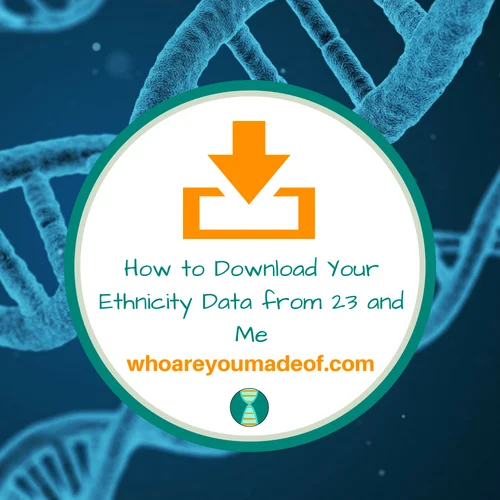
I really respect 23 and Me for allowing its users to download this data - such an interesting tool and wonderful information to have access to. If you didn't test with 23 and Me, it's probably worth doing a test only to get access to this data (though you'll learn other cool things about your ancestry, too).
In fact, this is exactly why I ordered 23andMe kits for both of my parents. I wanted more detail on exactly which lines of my family tree I would need to look to find the regions that I saw on my DNA results.
Why you should download your 23 and Me Ancestry composition ethnicity data
It's wonderful to look at a pie chart and maps or a list of percentages related to our "ethnicity", but wouldn't it be great if you could access information that could help you figure out exactly where those ethnicity percentages may have come from? This is exactly the type of thing that you could learn from downloading your data.
Contained within your downloaded ethnicity data from 23andMe is the exact chromosome number and location of DNA segments matching the regions that show up on your 23andMe results.
Let me show you a little example related to my small percentage of Ashkenazi Jewish. I opened up the file containing the information that I downloaded in Notepad.
You can open it in Excel or even Word. You can see in the image below that I have six segments on Copy 1 of five chromosomes that match the 23andMe Ashkenazi Jewish profile. The data tells me the exact start and end point of these segments:

For someone who is very interested in DNA and genealogy (or genetic genealogy, as it is often called) this type of information can be exceptionally helpful. Once I figure out which side of my family I got Copy 1 of my chromosomes from* (maternal or paternal), then I might be able to find DNA matches who share these DNA segments with me.
*We have two copies of each chromosome, one from each of our parents
Once I have groups of DNA matches on these segments, I can examine their family trees and possibly spot the ancestors from whom I inherited these segments.
And of course, once I spot the ancestors from whom I inherited my Ashkenazi Jewish ancestry, I can research them with the knowledge that they have Jewish roots - a helpful detail in genealogy.
Sounds great, right?
If it sounds complicated and intimidating, don't worry, I will give you a great suggestion for a free tool that you can use to easily do exactly what I described above. You'll find details about it towards the end of this post.
So, without further ado...
How to download your ethnicity data on 23 and Me
The first thing that you'll do is log in to your 23 and Me account. From your main dashboard on the top menu, click on "Ancestry and Traits" to access your Ancestry reports, and select "Ancestry Composition Report" from the drop down menu.
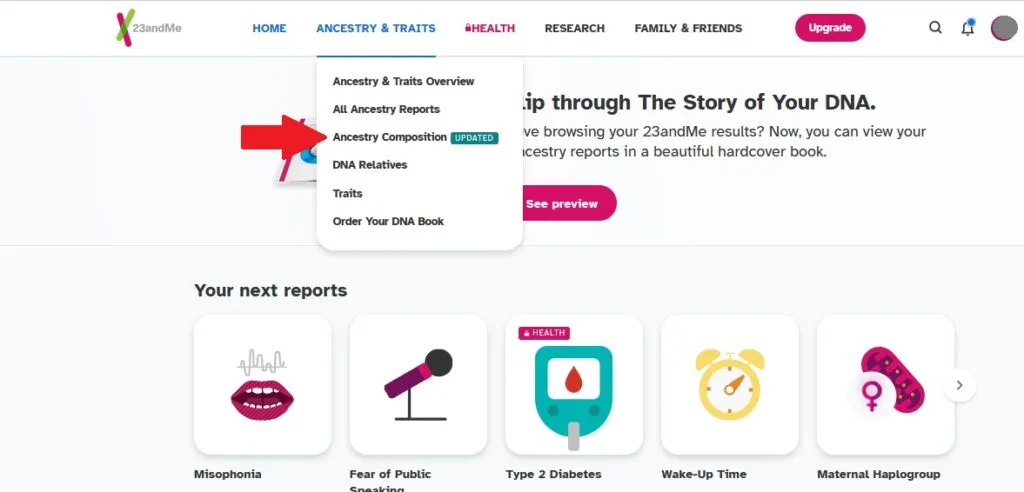
Once you are looking at your Ancestry Composition report on your 23 and Me account, you can scroll down to the bottom of the ethnicity percentages (about ⅓ of the way down the page) and click on "See All Tested Populations".
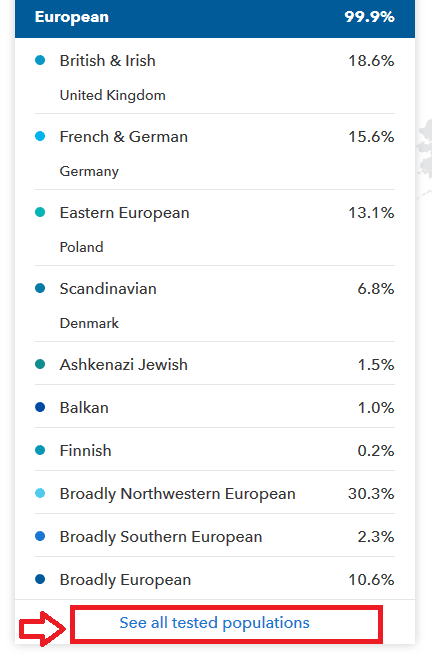
Finally, once you scroll down to the end of all of the potential regions that they tested your DNA for, you'll see an option to download your DNA. It's about ¾ of the way down the page, right above where they have information about their reference data sets:
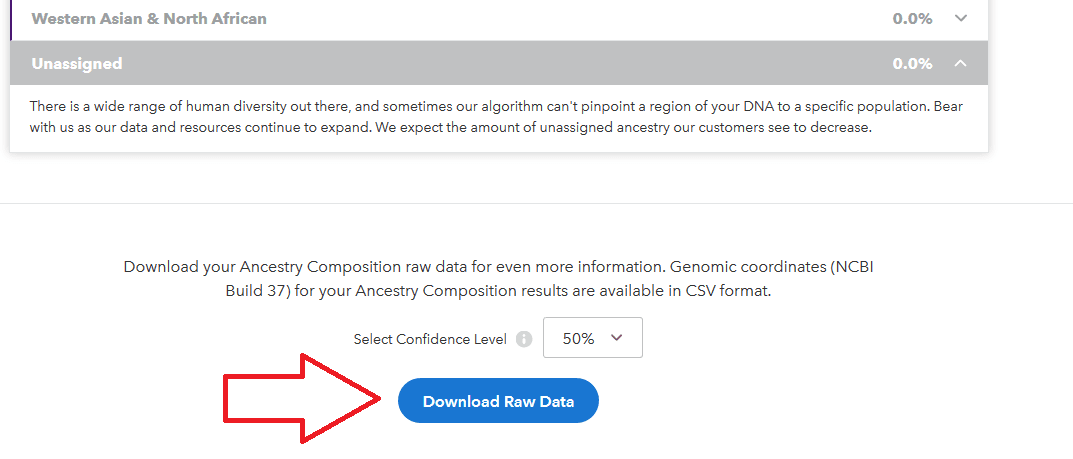
As soon as you press the "Download Raw Data" button, your download will begin. You might have to specify whether you want to open the file or save it to your computer (I recommend saving the file).
The exact process for completing your download will depend on the type of computer you are using and the settings you have previously chosen for downloads. Your file should be saved in the folder where you usually find files you have downloaded from the internet.
You'll notice that you can choose the "confidence level" for your download. The default is 50%, but you can use the dropdown menu to change this to 50%, 60%, 70%, 80%, or 90%.
If you want to have data from different confidence levels, you will have to download multiple files. For example, you can do a 90% download and then an 80% download.
I recommend downloading the 50% (speculative) and the 90% files. The data in the file containing information that has a 50% confidence level, while speculative, can contain valuable information.
You can decide whether to use it, or not. The data in the 90% confidence level file will be more general, but still good to have for reference.
Alternatively, you can explore the confidence levels in the chromosome painting part of your Ancestry Composition report and see at which confidence level the ethnicity that you are most interested in researching still appears (i.e. 70%) and download the ethnicity data at that confidence level.
What to do with ethnicity data file from 23 and Me
Unless you've been doing genetic genealogy for years, you probably don't have a big spreadsheet with DNA segment information on all of your DNA matches. To be honest, neither do I!
I like to use something much more fun, and a whole lot easier. There is a very helpful site called DNA Painter that is free to use as a basic user.
This site helps you easily map your chromosomes, assigning individual DNA segments - via information gathered from chromosome browsers - to individual ancestors.
(Helpful post is in the works about exactly how to import ethnicity into DNA Painter)
And guess what? Just like we can "paint" in a match (super easy - it's automatic), we can paint our DNA segments with our ethnicity data, too. The only thing that gets tricky is knowing which copy corresponds to your maternal and paternal lines.
Once you figure this out, though, you can easily spot which ancestors (through DNA matches that you have painted) correspond to which ethnicity regions.
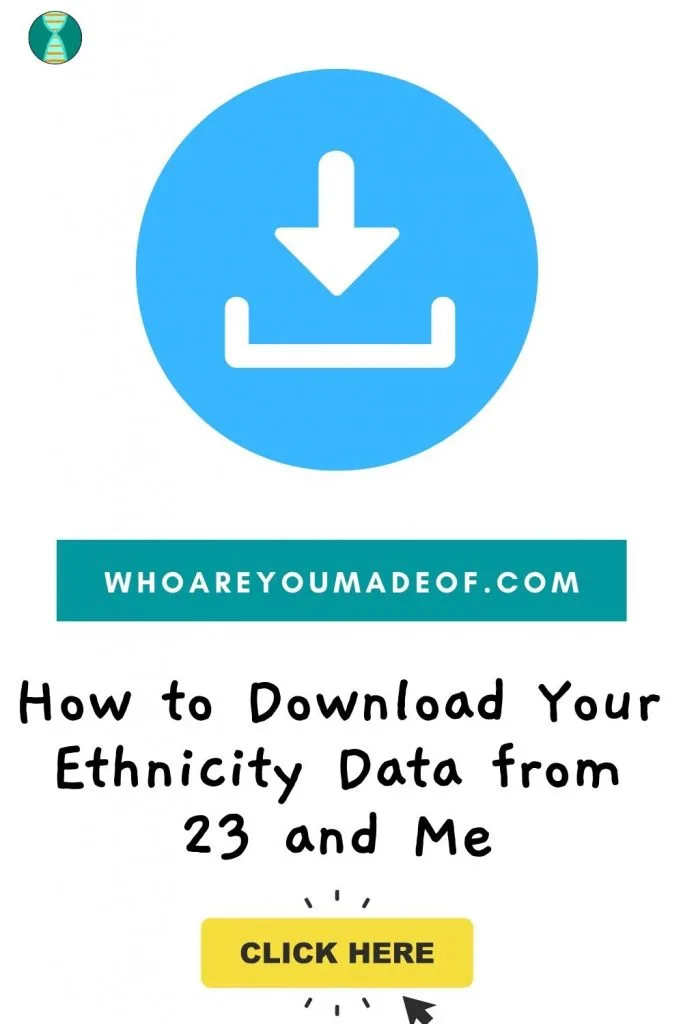
Conclusion
I hope that this post gave you an idea about what to do with your ethnicity data from 23 and Me, and more interestingly, what you might be able to learn from it. If you have any questions or comments about something that you read in this post, I would love to hear from you in the comments.
Thanks for stopping by!

Alexandra Cloud
Tuesday 2nd of June 2020
Hi Mercedes, thanks for your reply. So I don't have to try to fix an error that isn't there, just keep good records of who's who per chromosome pair! However, when segments from matches are imported into DNA Painter, and I specify maternal or paternal, would then some segments end up on the wrong chromosome copy "number" and not match the correct ethnicity (assuming DNA Painter assigns, for example, all copy 1 to maternal and copy 2 paternal)? Perhaps when importing I have to specify "unknown" (rather than maternal/paternal) and then assign each match segment to a particular chromosome copy so it matches the correct ethnicity? My challenge is sorting out segments on my maternal chromosome to try to find an unknown grandfather in an endogamous population. However, I've stopped focusing on this as my only goal and am enjoying placing distant relatives from my childhood on the family tree as I'm learning and finding distant unknown cousins practically on my doorstep. Amazing! Thanks again for your great posts, best wishes, Alexandra
Alexandra M E Cloud
Monday 2nd of March 2020
Hi Mercedes, awesome post as per usual, thanks so much for all your work, I'm a big fan. I do hope you write the post you mentioned above "(Helpful post is in the works about exactly how to import ethnicity into DNA Painter)", if not already finished! I have managed to import my ethnicity data into DNA painter but might have missed an important step or made a basic error. I did ask DNA painter to make copy 1 "paternal" and copy 2 "maternal". When the ethnicity data came in to DNA painter, I found, of course, that the maternal and paternal didn't match the copy number, because neither 23andme nor DNA painter knows who's who in my ancestry (neither parent having taken a DNA test and are now deceased). However, my mother was very close to 100% Ashkenazi Jewish, and my Dad 0% or, who knows, a tiny bit Ashkenazi Jewish, so it's easy to see which copy belongs to which parent.
So, re your comment, "The only thing that gets tricky is knowing which copy corresponds to your maternal and paternal lines. Once you figure this out, though, you can easily spot which ancestors (through DNA matches that you have painted) correspond to which ethnicity regions", can you edit the copy number in DNA painter to match the parent? so all the paternal copies are, for example 1, and all the maternal "2"?
Mercedes
Thursday 5th of March 2020
Hi Alexandra, It is possible for the copies to alternate, although they don't have to. This means that you might have to figure out which copy is maternal and paternal on each chromosome. It makes it extra tricky, yet fun, to work on. I hope that this helps - Mercedes